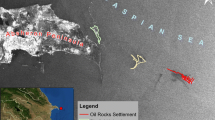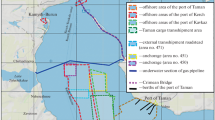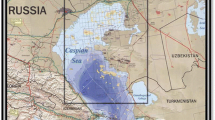Abstract
Accidental oil spills in the near-shore regions create severe impacts on coastal environments. The bulk carrier MV Wakashio ran aground off Southeastern Mauritius (SEM) on 25 July 2020, resulting in ~1000 tons of oil spillage into the Indian Ocean. The Sentinel-1 synthetic aperture radar (SAR) imagery is used to track and delineate the spilled oil and the affected coastal regions of Mauritius. The results depict that the spilled oil is primarily drifted towards the northwest, and beached along the SEM coastline, covering an area of ~24.42 km2 on 10 August. Within 6 days, the prevailing spill spreading has significantly reduced to ~5.1 km2 (on 16 August) and was almost the same even on 22 August. Subsequently, the spill spreading area has diminished further and more or less disappeared on 15 September. The assessment of SAR imagery corresponding to prevailed winds, tides, Stokes drift and currents illustrated that the spill has primarily drifted northwestwards owing to the force instigated by winds, Stokes drift and tides. This study recommends Sentinel-1 imagery to assess any such oil spill incidents in the future.
Highlights
-
Sentinel-1 satellite imagery has successfully captured the spreading of the Wakashio spill.
-
The northwestward drift of spill was primarily due to wind, Stokes drift and tides.
-
The spill deposition is significant along 28 km of coastline from Pointe d’Esny.
-
There was no significant evidence of the southward movement of the oil spill.
-
Sentinel-1 provides a promising imagery results to study any oil spill event.







Similar content being viewed by others
References
Alphers W and Espedal H A 2004 Oils and surfactants; In: Synthetic aperture radar marine user’s manual (eds) Jackson C R and Apel J R, National Oceanic and Atmospheric Administration, Washington, DC, Vol. 11, pp. 263–275.
Alves A C F, Santos W E and Creão-Duarte A J 2014 Diptera (Insecta) de importância forense da região neotropical; Entomotropica 29(2) 77–94.
Amir Heidari P, Arneborg L, Lindgren J F, Lindhe A, Rosen L, Raie M, Axell L and Hassellov I M 2019 A state of the art model for spatial and stochastic oil spill risk assessment: A case study of oil spill from a shipwreck; Env. Int. 126 309–320.
Appadoo C, Rabi F D, Antha S, Bastienne L J, Hurbungs M, Mougal J, Bosire J O, Mangora M M, Bandeira S, Rajkaran A, Ratsimbazafy R, Appadoo C and Kairo J G 2017 Mangroves of the western Indian Ocean: Status and management; WIOMSA 7 115–134, ISBN: 978-9987-9559-4-7.
Ardhuin F, Rogers E, Babanin A V, Filipot J F, Magne R, Roland A, Westhuysen A, Queffeulou P, Lefevre J M and Collard L A F 2010 Semi-empirical dissipation source functions for ocean waves: Part I: Definition, calibration, and validation; J. Phys. Oceanogr. 40 1917–1941.
Bayramov E, Kada M and Buchroithner M 2018 Monitoring oil spill hotspots, contamination probability modelling and assessment of coastal impacts in the Caspian Sea using Sentinel-1, Landsat-8, Radarsat, Envisat and ERS satellite sensors; J. Oper. Oceanogr. 11(1) 27–43.
Brekke C and Solberg A 2005 Oil spill detection by satellite remote sensing; Remote Sens. Env. 95(1) 1–13.
Castanedo S, Medina R, Losada I J, Vidal C, Méndez F J, Osorio A, Juanes J A and Puente A 2006 The prestige oil spill in Cantabria (Bay of Biscay): Part I: Operational forecasting system for quick response, risk assessment, and protection of natural resources; J. Coast. Res. 22 272–287.
Chaturvedi S K, Banerjee S and Lele S 2020 An assessment of oil spill detection using Sentinel 1 SAR-C images; J. Ocean Eng. Sci. 5 116–135.
Chaudhary V and Kumar S 2020 Marine oil slicks detection using space borne and airborne SAR data; Adv. Space Res. 66(4) 854–872.
Daby D 2006 Current patterns and the distribution of benthic habitats in a coastal lagoon of Mauritius; Hydrobiol. J. 556 47–60.
Daling P S and Strom T 1999 Weathering of oils at sea: Model/field data comparisons; Spill Sci. Technol. Bull. 5(1) 63–74.
Duke N C and Burns K A 2003 Fate and effects of oil and dispersed oil on mangrove ecosystems in Australia; Report to the Australian petroleum production and exploration association, pp. 232–363.
Durgadoo J V, Biastoch A, New A L, Ruhs S, Nurser A J G, Drillet Y and Bidlot J R 2019 Strategies for simulating the drift of marine debris; J. Oper. Oceanogr., https://doi.org/10.1080/1755876X.2019.1602102.
El-Magd I Abou, Zakzouk M, Abdulaziz A M and Ali E M 2020 The potentiality of operational mapping of oil pollution in the Mediterranean Sea near the entrance of the Suez Canal using Sentinel-1 SAR data; Remote Sens. 12(8) 1352.
Etnoyer P J, Wickes L N, Silva M, Dubick J D, Balthis L, Salfado E and MacDonald I R 2016 Decline in condition of gorgonian octocorals on mesophotic reefs in the northern Gulf of Mexico, before and after the deepwater horizon oil spill coral reefs; 35 77–90.
Faure G 1975 Etude comparative des récifscoralliens de larchipel des Mascareignes (Ocean Indian); Mauritius Inst. Bull. VIII 1–33.
Fingas M F 2012 How to measure slick thickness (or not); In: Proceedings of the 35th AMOP technical seminar on environmental contamination and response 5–7 617–652.
Fingas M F and Brown C E 1997 Review of oil spill remote sensing; Spill Sci. Technol. Bull. 4(4) 199–208.
Fingas M and Brown C 2018 A review of oil spill remote sensing; Sensors 18 91.
Gao F, Xue X, Sun J, Wang J and Zhang Y 2016 A SAR image despeckling method based on two-dimensional transform shrinkage; IEEE Trans. Geosci. Remote Sens. 54 3025–3034.
Garcia Pineda O, Staples G, Jones C E, Hu C, Holt B, Kourafalou V, Graettinger G, DiPinto L, Ramirez E and Streett D 2020 Classification of oil spill by thicknesses using multiple remote sensors; Remote Sens. Env. 236 111–421.
Garcia Pineda O, Zimmer B, Howard M, Pichel W, Li X F and MacDonald I R 2009 Using SAR image to delineate ocean oil slicks with a texture classifying neural network algorithm (TCNNA); Can. J. Remote Sens. 35(5) 411–421.
Gasco F, Bouzinac C, Thépaut O, Jung M, Francesconi B, Louis J and Languille F 2017 Copernicus Sentinel-2A calibration and products validation status; Remote Sens. 9(6) 584.
Hersbach H, Bell B, Berrisford P, Horanyi A, Sabater J M, Nicolas J, Radu R, Schepers D, Simmons A, Soci C and Dee D 2019 Global reanalysis: ERA interim, ERA5: ECMWF; Newsletter 159 17–24.
ITOPF 2020 Oil tanker spill statistics 2019; Special edition, 50 years of data 1970–2019.
Jiao Z, Yuan S, Zhang Z and Wang Q 2019 Machine learning prediction of hydrocarbon mixture lower flammability limits using quantitative structure property relationship models; Process. Saf. Prog. 39(3) 1–9.
Kim N, Kim S, Nahm M, Kopke D, Kim J, Cho E, Lee M J, Lee M, Kim S H, Broadie K and Lee S 2019 BMP-dependent synaptic development requires Abi-Abl-Rac signaling of BMP receptor macro pinocytosis; Nat. Commun. 10(1) 684.
Kubat M, Holte R and Matwin S 1998 Machine learning for the detection of oil spills in satellite radar images; Mach. Learn. 30 195–215.
Lee L et al. 2015 Chromatin remodelling factors Isw2 and Ino80 regulate check point activity and chromatin structure in S phase; Genes (Basel) 199(4) 1077–1091.
Lee K-H, Kim T-G and Cho Y-H 2020 Influence of tidal current, wind, and wave in Hebei spirit oil spill modelling; J. Mar. Sci. Eng. 8(2) 69.
Leifer I, Lehr W J, Simecek-Beatty D, Bradley E and Clark R 2012 State of the art satellite and airborne, marine oil spill remote sensing: Application to the BP deepwater horizon oil spill; Remote Sens. Env. 124 185–209.
Lewis D 2020 How Mauritius is cleaning up after major oil spill in biodiversity hotspot; https://www.nature.com/articles/d41586-020-02446-7.
Liu S, Chi M, Zou Y, Samat A, Benediktsson J A and Plaza A 2017 Oil spill detection via multi temporal optical remote sensing images; A change detection perspective; IEEE Geosci. Remote Sens. 14 324–328.
MacDonald I R, Daneshgar Asl S and Garcia Pineda O M 2013 Surface oil drift rates estimated from natural seeps; In: Gulf of Mexico oil spill and Ecosystem Science Conference, Ocean Springs.
McIntire W G and Walker H J 1964 Tropical cyclones and coastal morphology in Mauritius; Ann. Am. Assoc. Geogr. 54 582–596.
Migliaccio M A, Gambardella and Tranfaglia M 2007 SAR polarimetry to observe oil spills; IEEE Trans. Geosci. Remote Sens. 45 506–511.
Mihoub Z and Hassini A 2014 Monitoring and identification of marine oil spills using advanced synthetic aperture radar images; Appl. Opt. 44 433–449.
Naim O, Cuet P and Mangar V 2000 The Mascarene islands; In: Coral reefs of the Indian ocean: Their ecology and conservation (eds) McClanahan T R, Sheppard C R C and Obura D O, J. Exp. Mar. Biol. Ecol. 273 353–381.
National Parks and Conservation Services 2006 National biodiversity strategic and action plan; https://www.cbd.int/doc/world/mu/mu-nbsap-01-en.pdf.
Naz S, Muhammad Farooq, Iqbal, Irfan, Mahmood and Mona Allam 2021 Marine oil spill detection using synthetic aperture radar over Indian ocean; Mar. Pollut. Bull. 162 111921.
NOAA 2003 National Center for Environmental Information, state of the climate: Global climate report for annual 2002, https://www.ncdc.noaa.gov/sotc/global/200213.
NOAA 2014 Oil spills in mangroves: Planning and response considerations; US Department of Commerce, National Oceanic and Atmospheric Administration (NOAA).
Pan Q, Yu H, Daling P S, Zhang Y, Reed M, Wang Z, Li Y, Wang X, Wu L, Zhang Z, Yu H and Zou Y 2020 Fate and behavior of Sanchi oil spill transported by the Kuroshio during January–February 2018; Mar. Pollut. Bull. 152 110917.
Prasad S J, Balakrishnan Nair T M, Rahaman H, Shenoi S S C and Vijayalakshmi T 2018 An assessment on oil spill trajectory prediction: Case study on oil spill off Ennore Port; J. Earth Syst. Sci. 127 111.
Prastyani R and Basith A 2018 Utilisation of Sentinel-1 SAR imagery for oil spill mapping: A case study of Balikpapan Bay Oil Spill; J. Geospatial Inf. Sci. Eng. 1 22–26.
Raeisi A, Akbarizadeh G and Mahmoudi A 2018 Combined method of an efficient cuckoo search algorithm and non-negative matrix factorization of different Zernike moment features for discrimination between oil spills and look-alikes in SAR images; IEEE J. Sel. Top. Appl. Earth Obs. Remote Sens. 11 4193–4205.
Rajendran S, Vethamony P, Sadooni F N, Al-Kuwari H, Al-Khayat J A, Seegobin V O, Govil H and Nasir S 2021 Detection of Wakashio oil spill off Mauritius using Sentinel-1 and 2 data: Capability of sensors, image transformation methods and mapping; Env. Pollut. 274 116618.
Reed S H 1999 Yeast autonomously replicating sequence binding factor is involved in nucleotide excision repair; Genes Dev. 13(23) 3052–3058.
Runghen H, Bhuruth M, Rughooputh S D D V and Rughooputh H C S 2003 ICIT, Maribor, Slovenia.
Sebastiao P and Guedes S C 1995 Modelling the fate of oil spills at sea; Spill Sci. Technol. Bull. 2 121–131.
Sivadas E, Bruvold N T and Nelson M R 2008 A reduced version of the horizontal and vertical individualism and collectivism scale: A four-country assessment; J. Bus. Res. 61(3) 201–210, https://doi.org/10.1016/j.jbusres.2007.06.016.
Sobey R J and Barker C H 1997 Wave-driven transport of surface oil; J. Coast. Res. 13(2) 490–496.
Suneel V, Trinadha Rao V, Suresh G, Chaudhary A, Vethamony P and Ratheesh R 2019 Oil pollution in the eastern Arabian Sea from invisible sources: A multi-technique approach; Mar. Pollut. Bull. 146 683–695.
Suresh G, Heygster G, Bohrmann G, Melsheimer C and Körber J H 2013 An automatic detection system for natural oil seep origin estimation in SAR Images; IEEE Geosci. Remote Sens. Symp., pp. 3566–3569.
Suresh G, Heygster G, Melsheimer C and Bohrmann G 2014 Natural oil seep location estimation in SAR images using direct and contextual information; Proceedings of the IEEE Geosci. Remote Sens. Symp. – IGARSS, pp. 1678–1681.
Suresh G, Melsheimer C, Korber J H and Bohrman G 2015 Automatic estimation of seep locations in synthetic aperture radar images; IEEE Trans. Geosci. Remote Sens. 53(8) 4218–4230.
Tian Y et al. 2017 Construction and comparison of yeast whole-cell biosensors regulated by two RAD54 promoters capable of detecting genotoxic compounds; Toxicol. Mech. Methods 27(2) 115–120.
Tong S, Liu X, Chen Q, Zhang Z and Xie G 2019 Multi-feature based ocean oil spill detection for polarimetric SAR data using random forest; Remote Sens. 11 451.
Topouzelis K and Singha S 2017 Oil spill detection using space-borne Sentinel-1 SAR imagery; Oil Spill Sci. Technol. 6.
Turner J R, Jago C, Daby D and Klaus R 2000 The Mascarene region; In: Seas at the millennium: An environmental evaluation (ed.) Sheppard C R C, Pergamon Elsevier, Vol. 2, pp. 253–268.
Vethamony P, Sudheesh K, Babu M T, Jayakumar S, Manimurali R, Saran A K, Sharma L H, Rajan B and Srivastava M 2007 Trajectory of an oil spill off Goa eastern Arabian Sea: Field observations and simulations; Env. Pollut. 148 438–444.
World Maritime News 2016 Update: Oil spill from grounded MV Benita under control; https://worldmaritimenews.com/.
Wulder M A, Loveland T R, Roy D P, Crawford C J, Masek J G, Woodcock C E and Dwyer J 2019 Current status of Landsat program, science, and applications; Remote Sens. Env. 225 127–147.
Xu Q, Li X, Wei Y, Tang Z, Cheng Y and Pichel W G 2013 Satellite observations and modelling of oil spill trajectories in the Bohai Sea; Mar. Pollut. Bull. 71 107–116.
Yang C S, Kim D and Oh J H 2009 Study on improvement of oil spill prediction using satellite data and oil-spill model: Hebei spirit oil spill; J. Remote Sens. 25(5) 435–444.
Zafirakou A 2018 Oil spill dispersion forecasting models; In: Monitoring of marine pollution (ed.) Fouzia H B, IntechOpen, London, United Kingdom, Vol. 7, pp. 1–20, https://doi.org/10.5772/intechopen.81764.
Zhang H X, Ji Q and Fan Y 2015 What drives the formation of global oil trade patterns; Energy Econ. 49 639–648.
Zhao J, Temimi M, Ghedira H and Hu C 2014 Exploring the potential of optical remote sensing for oil spill detection in shallow coastal waters – A case study in the Arabian Gulf; Opt. Exp. 22 13755.
Zhu Z, Wulder M A, Roy D P, Woodcock C E, Hansen M C, Radeloff V C and Pekel J F 2019 Benefits of the free and open Landsat data policy; Remote Sens. Env. 224 382–385.
Acknowledgements
We thank Prof Sunil Kumar Singh, Director, CSIR-National Institute of Oceanography, for his persistent encouragement towards this study. V Trinadha Rao acknowledges CSIR for providing fellowship and also AcSIR for granting PhD admission. We acknowledge Sentinel Scientific Data Hub, ECMWF-ERA5 (Winds), HYCOM (http://hycom.org) (Currents) and CMEMS (Stokes drift data) for providing various data sets used in this study. We also acknowledge ESA-SNAP and QGIS software, Ferret (PMEL, NOAA, USA) and GMT (Generic Mapping Tools) graphical tools, which were used for image processing and creating the figures used in this study. This is CSIR-NIO contribution number 6800.
Author information
Authors and Affiliations
Contributions
V Trinadha Rao: Conceptualisation, methodology, data processing, software, validation and writing – original draft. V Suneel: Conceptualisation, investigation, writing – review and editing, resources, supervision and funding acquisition. M J Alex: Methodology, visualisation and validation. K Gurumoorthi: Formal analysis and visualisation. Antony P Thomas: Data curation and visualisation.
Corresponding author
Additional information
Communicated by Aparna Shukla
Rights and permissions
About this article
Cite this article
Rao, V.T., Suneel, V., Alex, M.J. et al. Assessment of MV Wakashio oil spill off Mauritius, Indian Ocean through satellite imagery: A case study. J Earth Syst Sci 131, 21 (2022). https://doi.org/10.1007/s12040-021-01763-3
Received:
Revised:
Accepted:
Published:
DOI: https://doi.org/10.1007/s12040-021-01763-3




